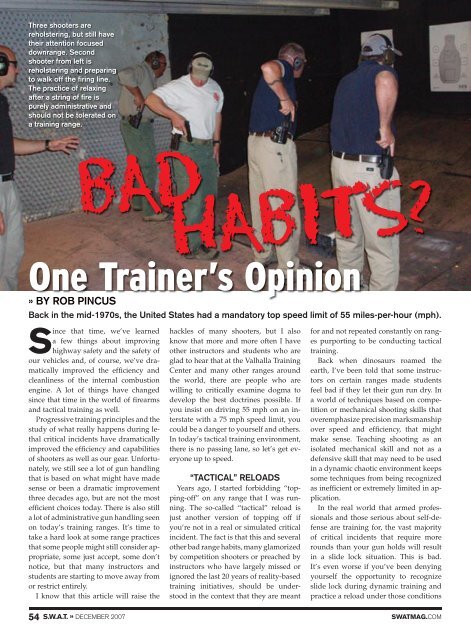S.W.A.T. December 2007 - McKeesport Police Department
S.W.A.T. December 2007 - McKeesport Police Department
S.W.A.T. December 2007 - McKeesport Police Department
Create successful ePaper yourself
Turn your PDF publications into a flip-book with our unique Google optimized e-Paper software.
Three shooters are<br />
reholstering, but still have<br />
their attention focused<br />
downrange. Second<br />
shooter from left is<br />
reholstering and preparing<br />
to walk off the fi ring line.<br />
The practice of relaxing<br />
after a string of fi re is<br />
purely administrative and<br />
should not be tolerated on<br />
a training range.<br />
One Trainer’s Opinion<br />
» BY ROB PINCUS<br />
BAD<br />
HABITS?<br />
Back in the mid-1970s, the United States had a mandatory top speed limit of 55 miles-per-hour (mph).<br />
Since that time, we’ve learned<br />
a few things about improving<br />
highway safety and the safety of<br />
our vehicles and, of course, we’ve dramatically<br />
improved the effi ciency and<br />
cleanliness of the internal combustion<br />
engine. A lot of things have changed<br />
since that time in the world of fi rearms<br />
and tactical training as well.<br />
Progressive training principles and the<br />
study of what really happens during lethal<br />
critical incidents have dramatically<br />
improved the effi ciency and capabilities<br />
of shooters as well as our gear. Unfortunately,<br />
we still see a lot of gun handling<br />
that is based on what might have made<br />
sense or been a dramatic improvement<br />
three decades ago, but are not the most<br />
effi cient choices today. There is also still<br />
a lot of administrative gun handling seen<br />
on today’s training ranges. It’s time to<br />
take a hard look at some range practices<br />
that some people might still consider appropriate,<br />
some just accept, some don’t<br />
notice, but that many instructors and<br />
students are starting to move away from<br />
or restrict entirely.<br />
I know that this article will raise the<br />
hackles of many shooters, but I also<br />
know that more and more often I have<br />
other instructors and students who are<br />
glad to hear that at the Valhalla Training<br />
Center and many other ranges around<br />
the world, there are people who are<br />
willing to critically examine dogma to<br />
develop the best doctrines possible. If<br />
you insist on driving 55 mph on an interstate<br />
with a 75 mph speed limit, you<br />
could be a danger to yourself and others.<br />
In today’s tactical training environment,<br />
there is no passing lane, so let’s get everyone<br />
up to speed.<br />
“TACTICAL” RELOADS<br />
Years ago, I started forbidding “topping-off”<br />
on any range that I was running.<br />
The so-called “tactical” reload is<br />
just another version of topping off if<br />
you’re not in a real or simulated critical<br />
incident. The fact is that this and several<br />
other bad range habits, many glamorized<br />
by competition shooters or preached by<br />
instructors who have largely missed or<br />
ignored the last 20 years of reality-based<br />
training initiatives, should be understood<br />
in the context that they are meant<br />
for and not repeated constantly on ranges<br />
purporting to be conducting tactical<br />
training.<br />
Back when dinosaurs roamed the<br />
earth, I’ve been told that some instructors<br />
on certain ranges made students<br />
feel bad if they let their gun run dry. In<br />
a world of techniques based on competition<br />
or mechanical shooting skills that<br />
overemphasize precision marksmanship<br />
over speed and effi ciency, that might<br />
make sense. Teaching shooting as an<br />
isolated mechanical skill and not as a<br />
defensive skill that may need to be used<br />
in a dynamic chaotic environment keeps<br />
some techniques from being recognized<br />
as ineffi cient or extremely limited in application.<br />
In the real world that armed professionals<br />
and those serious about self-defense<br />
are training for, the vast majority<br />
of critical incidents that require more<br />
rounds than your gun holds will result<br />
in a slide lock situation. This is bad.<br />
It’s even worse if you’ve been denying<br />
yourself the opportunity to recognize<br />
slide lock during dynamic training and<br />
practice a reload under those conditions<br />
54 S.W.A.T. » DECEMBER <strong>2007</strong> SWATMAG.COM


